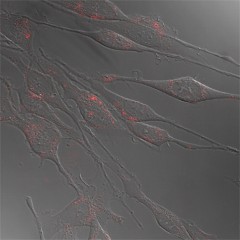Researchers at Vanderbilt University have developed a method to tag a protein called the serotonin transporter in human beings at the molecular level. Serotonin is a hormone that regulates appetite, mood and sleep in humans.
 Illuminated qunatum dots attached to serotonin transporters(Credit: Jerry Craig, Vanderbilt University)
Illuminated qunatum dots attached to serotonin transporters(Credit: Jerry Craig, Vanderbilt University)
The protein helps in regulating the level of serotonin around the cells by acting as a nanoscale vacuum cleaner in sucking the serotonin molecules into the cell and keeps them away from serotonin receptors on other cells. Serotonin transport is of immense interest to researchers of mental health and its treatment. It has great significance for autism too as previous studies found that changes in the serotonin transporter can cause the protein to become hyper. Previous attempts to track the protein have only yielded snapshots of the molecules at a given time. The new technique allows the real-time tracking of molecules on the surface of the cells.
The team made use of quantum dots of cadmium and selenium that are only slightly bigger than the proteins. Fellow researcher Ian D. Tomlinson synthesized a molecular string that fastens to a quantum dot at one end and a drug derivative capable of latching on to the protein transporter at the other end. Incubation of the quantum dots with a nerve cell culture facilitates the binding of the dots to the protein by means of the drug derivative. The proteins dragged the quantum dots wherever they travelled. Quantum dots have the property of lighting up in different colors when illuminated. In order to track the proteins, the scientists just had to illuminate the area for the dots causing them and thereby the proteins to show up as colored specks under the microscope. The development has many implications on therapy. Current treatment using antidepressants involve the shutting down of serotonin transporters in the brain for the drug to take effect. This is accompanied by undesirable side effects such as nausea, fatigue, sexual issues and weight gain. The study gives insight into the method of naturally controlling the levels of serotonin and could pave the way for development of drugs with milder side effects.